Holistic health
Holistic Health has five main aspects of personal health: physical, emotional, social, spiritual, and intellectual.
Have you been looking for a new way to heal?
How about connecting with unpopular or less traditional remedies to support the mind, body and soul?
Have you heard of “holistic” practice but unsure of where to begin?
Do you simply like a menu of options for an a la carte approach to your personal wellness?
Well you have come or stumbled upon the right spot because the Hip Lives, Health in Progress community revolves around all those inner questions and then some. We believe as one is always progressing throughout their life, that health is the one thing we can all agree – is never perfect. But that doesn’t mean there is a cookie cutter approach to how we best manifest, design and take control of the areas to which we know must all perform within us synergistically to best “progress” towards optimal wellness.
Each month we offer a new “tool” that is adapted from research both historically and medically as well as tried throughout the world and via its people. Our spiritual, intellectual, mental, physical and social approaches to progressing our health are designed from more of the unique array of methodologies we think are not only cost -effective (99% of the time, free) but are ways that we acknowledge are self guided so that if it’s not the best match for your wellness walk through life (or at this time in your life), well, then on to the next!
We are all unique and holistically, uniqueness is where we must really capture the oneness that has come together from others to support the oneness we all need to progress towards, within.
We must practice holistic care which emphasizes the connection of mind, body, and spirit. Our goal should be to achieve maximum well-being, where everything is functioning the very best that is possible. Mind, body and soul are aspects that each person should combine when striving to achieve the best optimal health.
HIP Lives considers a health in progress to be a holistic approach for healing, supporting and maintaining all of those areas within personal health.
Every person is their own individual so you may need guidance but will FEEL the results when you find the personal development that holistically works for you!


5 holistic health tools
emotional
Dialectical behavioral therapy
 Dialectical Behavioral Therapy (DBT) combines cognitive and behavioural therapy, incorporating methodologies from various practices including mindfulness techniques. It helps you manage emotions that may be overwhelming, break destructive impulse behaviours and help with relationships also.
Dialectical Behavioral Therapy (DBT) combines cognitive and behavioural therapy, incorporating methodologies from various practices including mindfulness techniques. It helps you manage emotions that may be overwhelming, break destructive impulse behaviours and help with relationships also.
DBT has recently been broadened from treating people with Borderline Personality Disorder to offering DBT for people with substance use issues, for adolescents, or for couples.
DBT Core Skills include Observation, Description, Participation, Mindfulness, Effectiveness and Non-Judgement.
The mindfulness skill is an effort to help us focus our attention on the here and now. This requires a lot of practice and willingness. Be patient with yourself and try not to be judgemental.
Being effective is often allowing ourselves to let go of feeling ‘right’ so strongly, that it overshadows our ability to make decisions that may correct a situation. Being determined to be right can be a very self-defeating decision. In other words, letting go of a desire to be right and doing what works using DBT skills is being effective.
 Validate your emotions as they represent experiences and interactions that were or are painful. You will need to deal with these emotions in a new way that will relieve some of the sufferings that go with them.
Validate your emotions as they represent experiences and interactions that were or are painful. You will need to deal with these emotions in a new way that will relieve some of the sufferings that go with them.
- Accept your emotions (they are real but can be let go if we also accept the suffering they cause us)
- Accept their negativity (don’t approve of the suffering they cause)
- Create distance from the emotion
- Stand back and observe it
- Describe in words what the experience of your emotion
- Expose this to yourself
- Replace the emotions by participation
- Increase positive emotions
- Find ways to have fun
- Be unmindful of worries and mindful of positives
- Work on relationships
- Be present
And remember: You can choose acceptance without choosing approval.
Reset Therapy
 RESET Therapy stands for Reconsolidation Enhancement Stimulation of Emotional Triggers. We dive into the process and research supported success shared by Dr. Lindenfeld, Ph.D who has years of case study completed with Veterans living with PTSD and removing this through RESET therapy at his practic
RESET Therapy stands for Reconsolidation Enhancement Stimulation of Emotional Triggers. We dive into the process and research supported success shared by Dr. Lindenfeld, Ph.D who has years of case study completed with Veterans living with PTSD and removing this through RESET therapy at his practic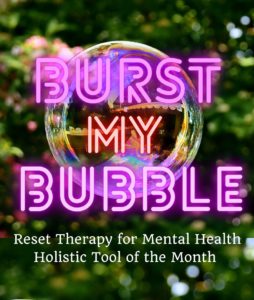
HOLISTIC TOOL OF THE MONTH
Mental Health pillar – RESET Therapy
RESET Therapy stands for Reconsolidation Enhancement Stimulation of Emotional Triggers which for anyone suffering from Post Traumatic Stress Disorder, addictions and some doctors believe it has a strong potential to help alzheimers patients as well. The way it works actually is in conjunction with a device known as BAUD, which stands for Bio Acoustical Utilization Device.
The BAUD has a little battery-driven device with four knobs that set off a sound of frequency. It is used to resonate with the trauma circuitry in the brain. It’s then offset by up to 20 hertz, which creates a special effect called a binaural beat. Nobody else can hear it, only the listener which is said to be the key in unlocking the trauma memory that then opens it up to alteration.
Memory consolidation is when memory is accessed experientially or as a person talks about it. Coherence Therapy is when we tap into the implicit emotional memory which opens up a window of 4 to 5 hours during which time that memory can be reconsolidated, reconstructed, re-interpreted – all these different words are there.
In Coherence Therapy, they’re doing this experiential process and juxtaposing an implicit truth from the past that’s related to trauma and implicit truth from the present, which is grounded in safety or the mature person who survives the trauma. In this work, you’re not doing any juxta positioning.
Dr. Lindenfeld, Ph.D. is a Clinical Psychologist and founder of the Medical Psychology Center in Asheville, NC, which specializes in the evaluation and treatment of traumatic life experiences. He served in the Navy Seabees prior to attaining his doctorate in Child and Developmental Psychology Ph.D. is a Clinical Psychologist and founder of the Medical Psychology Center in Asheville, NC, which specializes in the evaluation and treatment of traumatic life experiences. He served in the Navy Seabees prior to attaining his doctorate in Child and Developmental Psychology.
He has several books that dive deeper into the premise and purpose behind this therapy tool as well as the successful applications it has provided to date.
“Post-traumatic stress disorder (PTSD) has a prevalence of 6.8% among the American population and an even greater prevalence among combat veterans. The conventional view of PTSD has been to view it as a psychological adjustment disorder characterized by depression and anxiety in response to stressful circumstances. Recently, however, it has become apparent that it is much more than a psychological adjustment disorder. This began with the appreciation of the fact that dementia is much more common in PTSD than earlier thought, suggesting neurological changes associated with the disorder. There is now evidence for psychiatric changes (e.g., mood disorders, substance use and abuse), cardiovascular changes, auto-immune changes (e.g., rheumatoid arthritis), tumorigenic changes, etc. (Bukhbinder & Schulz, 2016).”
For more information and for healthcare professionals looking to become a trained RESET Therapy provider, please visit https://www.drlindenfeldresettherapy.com/. Hip Lives is not affiliated with Dr. Lindenfeld or his practice and cannot endorse this therapy except by admiration and interest sought for it’s global health change that it could provide. We will follow this closely.
tea-tox therapy
 Tool of the Month
Tool of the Month
Supports: Mental /emotional /spiritual/ physical
This tea meditation is simple, easy to do, and profoundly nourishing and beneficial.
Adapted from Buddhaimonia
The steps are as follows:
- Make your tea
You should do everything– from each step of preparing your tea, to sitting down, to drinking your tea, to finishing, and cleaning up- in mindfulness.
No matter how you choose to prepare your tea, what tea you drink, where you drink your tea, do so carefully with a complete awareness of the present moment. Give yourself completely to the entire process of preparing and drinking your tea.
Once your tea is made, find a nice quiet place for you to sit and drink it. Once you’ve sat down, take a moment before starting to “simply sit” with your tea.
Notice the aroma of the tea, admire the look and color of the tea, and imagine the delicate balance that had to be kept for the tea to go from being a leaf on a tree (likely from another country) to becoming the delightful cup of tea in front of you.
- Give thanks
Before you begin drinking, take a moment to give thanks for the cup of tea in front of you.
Contemplate for a moment on the fact that people all around the world don’t even have clean drinking water, yet you can sit and enjoy an amazing cup of warm tea whenever you so choose.
Appreciate the cup of tea and everything that had to happen, and the careful balance that had to be maintained, for you to experience this amazing cup of tea.
Express your gratitude for all those things which helped make your cup of tea a reality, and for a moment expand that thought to yourself and the knowledge that you also depend on infinite living and non-living things to exist as you are now in this moment just as the tea does.
Sit with those feelings for a minute or two before beginning.
- Drink your tea
This is the main event. Your tea has been prepared, you’ve expressed your appreciation, and now it’s time to drink.
All you have to do is drink your tea fully with mindfulness. Take it slow, only drinking very small sips at a time. You should be taking your time and really savoring every sip.
Specifically, while you drink, your object of concentration can be various things.
Your concentration surrounding your actions while drinking the tea can be as simple as thinking about lifting your arm with your cup, bringing to your lips, considering the motions from sip to swallow as you feel the motion of your arm coming back to rest. This should be repeated in your meditation motions and mindfulness.
And as usual, any thoughts, feelings, or sensations that arise while doing each individual activity simply gets gently acknowledged and I proceed to go back to my object of meditation.
Fully commit to the act of drinking your tea, whether you’re with someone else or alone. Be fully awake for the practice of drinking your tea, understanding that this moment and this tea will never exist again.
- Give thanks (again)
Once you’re done (again, the length of your meditation is up to you, it could be 10 minutes and it could be one hour), give thanks once again like you did in the beginning.
It’s important to finish the practice like you started, helping put the tea, and the meditation, in perspective.
This simple tea meditation, which can be done in as little as 10 minutes and as long as one full hour (it’s really up to you), has a whole list of great benefits:
- Cultivate a sense of gratitude and a deep reverence for life
- Reduce stress and find greater peace and clarity of mind
- It’s a great morning ritual to start your day off with
- All the benefits of meditating with mindfulness
- All the health benefits of drinking tea (depends on what tea you drink, but many types of tea are very healthy)
- Great preparatory as well as supporting practice for your sitting meditation
- It’s great to invite friends and family in on to show them the same benefits and to nurture your relationships
music therapy

The Power of Music
The skills you need states, it’s well-established fact that music can alter our mood, stir emotions and may even lead us to behave in unusual ways. There are many ways that music can make us feel, including:
- Patriotic – National anthems and other music associated with a country or geographic area.
- Loyalty – Music and sounds associated with sports events, schools, clubs and other organisations.
- Spiritual – Hymns, chants, gospel and other music and sounds associated with religion or the divine.
- Nostalgic – Music can remind us of the past, both good times and bad times.
- Love – Music can be used to express love and as a sign of affection.
- Hate – Music can be used in war and violence and to promote anger.
- Energetic – Rhythms in music can make us tap our feet, clap our hands and dance. M
- usic can aid physical exercise.
- Happy – Music can lift our mood, make us smile, laugh and sing along.
- Sad – Music can make us feel melancholy, gloomy or even depressed. Music can make us cry.
- Excited – Music is often used to excite us, like at a funfair or during some tense moment in a movie.
- Irritated – Music we don’t like can irritate us, as can an ‘ear-worm’ , a tune that gets stuck in your head and is repeated over and over.
- Unexplained – Sometimes music can cause more unexplained physical reactions, like the hairs standing up on the back of your neck or goosebumps which are more commonly associated with strong feelings of nostalgia, pleasure, euphoria, astonishment or awe.
Read more at: https://www.skillsyouneed.com/ps/music-therapy.html
laughter yoga

Laughter Yoga includes four things:
- Clapping in rhythm to ‘ho-ho-ha-ha-ha’.
- Breathing and stretching.
- Child-like play.
- Laughter exercises.
Laughter comes from the body not the mind.
There are tons of therapy videos but we found this one not only therapeutic but also actually hilarious
art therapy
Creating art can help you acknowledge and recognize feelings that have been lurking in your subconscious thus providing Self-discovery.
Self-discovery.
Self–esteem: The process will give you a feeling of self-accomplishment which can be very valuable to improve your self-appreciation and confidence.
Art therapy exercises for depression use direction to explore emotions and awareness. Create a therapy routine with the useful advice from a trained art therapist in this free video on art therapy exercises for depression.
https://www.youtube.com/watch?v=n8zlBJDZanc
Expert: Deb Shoemaker
Contact: www.debshoemaker.com/
Bio: Deb Shoemaker is trained in Art Therapy Assessments, DBT, and CBT.
Filmmaker: Rendered Communications
Art therapy offers structure and release, helping to treat a number of issues. Discover more about art therapy in this free video series presented by a certified therapist
healing therapy
 Shinrin-Yoku (forest bathing therapy):
Shinrin-Yoku (forest bathing therapy):
Simply put, it is tree therapy. People spend up to three hours walking under trees; in parks, woods and forests, simply taking in their surroundings and feeling the atmosphere. Scientists note that exposure to the phytoncide chemical released by vegetation strengthens the immune system, brings down blood pressure, reduces cortisol levels and boosts concentration and memory.
Doctors at the Nippon Medical School in Tokyo believe it can combat ailments of the mind and body such as cancer, strokes, gastric ulcers, depression, anxiety and stress.
Every study conducted so far has demonstrated reductions in stress, anger, anxiety, depression and sleeplessness amongst the participants. In fact after just 15 minutes of forest bathing blood pressure drops, stress levels are reduced and concentration and mental clarity improve.
If you think it all sounds too good to be true, why not give it a go yourself? You don’t have a forest or woodland nearby, you can also practice Shinrin-Yoku in the park. Just follow this short guide…
- Step 1 – leave behind your phone, camera or any other distractions, so that you can be fully present in the experience.
- Step 2 – Leave behind your goals and expectations. Wander aimlessly, allowing your body to take you wherever it wants.
- Step 3 – Pause from time to time, to look more closely at a leaf or notice the sensation of the path beneath your feet.
- Step 4 – Find a comfy spot to take a seat and listen to the sounds around you. See how the behaviour of the birds and other animals changes when they become used to your presence.
- Step 5 – If you go with others, make an agreement to resist talking until the end of the walk, when you could gather to share your experiences.
physical
Tai-Chi
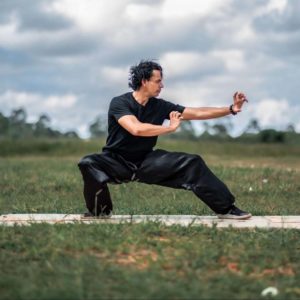
Tai chi (also written as T’ai Chi, Taiji, Tai Chi Chuan, etc.) is an ancient Chinese exercise system (originating 2,000 years ago as a martial arts strategy) that uses gentle, slow, deliberate, meditative body movements (and carefully prescribed stances/positions) to achieve mental and bodily relaxation. One of the most popular forms of exercise in the world, it was originally practiced as 108 complex, linked movements – but in current practice the two most popular versions use 18 and 37 movements. Often described as “meditation in motion.”
Tai chi is low impact and puts minimal stress on muscles and joints, making it generally safe for all ages and fitness levels. In fact, because tai chi is a low-impact exercise, it may be especially suitable if you’re an older adult who otherwise may not exercise.
The benefits of tai chi may include:
- Decreased stress, anxiety and depression
- Improved mood
- Improved aerobic capacity
- Increased energy and stamina
- Improved flexibility, balance and agility
- Improved muscle strength and definition
Some evidence indicates that tai chi may also help:
- Enhance quality of sleep
- Enhance the immune system
- Help lower blood pressure
- Improve joint pain
- Improve symptoms of congestive heart failure
- Improve overall well-being
- Reduce risk of falls in older adults
Below are two basic tai chi motions to try. One important thing to keep in mind is that this exercise isn’t just about getting to the right position — it’s also about the flow of the movement itself into the next form.
White Crane Spreads Wings: Placing nearly all your weight on your right foot, turn your waist slightly to the right. Then, raise your right hand with your palm facing your body. Your left palm should be facing the ground, and your left heel should be slightly off the ground. In this position, keep coiling your waist to the right.
Snake Creeps Left: Beginning in a standing position, slowly crouch down to a deep hamstring lunge with one knee bent and your other leg straight and out to the side. Extend the arm that’s on the same side of your body as your bent leg straight out to the same side. Press your other arm — the one on the same side as your straightened leg — downward with the palm facing the ground. Remember to do these motions evenly and slowly.
Sound meditation
Sound meditation is the use of sound as a tool to cultivate and support deep relaxation. The purpose of sound meditation is to create a gentle, yet powerful experience that heals the body, clears the mind and heightens your meditation practice by helping rein in your attention to the present.
While there are different kinds of instruments used for sound meditation with their own benefits, there are 3 types of singing bowls – Tibetan, Crystal and Alchemy. The Alchemy singing bowl has increased in popularity over recent years due to the incredible healing power behind its sound and its unique ability to penetrate our bodies. Not to mention, they sound like you’re literally in heaven.
Alchemy Crystal singing bowls are advanced crystal singing bowls, where colourful crystals, fine gemstones and precious metals, such as 24 karat gold, silver and platinum are heated and blended in with the quartz bowls. They are precious, produced in a unique way and come at the highest price point – not one bowl is ever the same. The humming sounds are heard by the ear and felt through the body, affecting your energy centers (chakras) for healing, balancing & meditation.
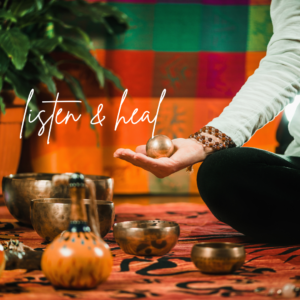

How it works
The optimal brainwave frequency for relaxation and de-stressing is between alpha (relaxed state) and theta (deep meditation and light sleep state), where we are conscious of our surroundings but we feel deeply relaxed and in control of our thoughts and feelings. The alchemy singing bowls help transition you from beta (awake and alert) to theta (deep meditation and light sleep) during your sound meditation practice at Mirosuna.
When the alchemy singing bowl is played, its materials are doing their own work to enhance the sounds we hear. The harmonic and pure tones made by alchemy singing bowls are not just heard by the ear, but by the whole body – with certain tones affecting your energy centers for meditation, balancing and healing.
Because our bodies – right down to our DNA, are also crystalline in structure, there can be overwhelming effects on the circulatory, metabolic and endocrine systems, as well as the organs, tissues and cells when working with alchemy singing bowls.
“When played, these alchemy bowls help entrain us energetically to higher, more refined, vibratory frequencies. Often… and sometimes this happens literally in a matter of moments…hearing the sound of an alchemy crystal singing bowl can initiate profound shifts in wellbeing, relaxation, awareness and expansion of consciousness” says renowned crystal bowl master, Ashana.
solution-based therapy
 Psychotherapy is one of the clinical practices that go hand in hand with traditional therapies. Many of which we haven’t dived into as the tools provided in our holistic health hub so far have been ones that we encourage you to incorporate into your healing routine with or without physician support – because you can!
Psychotherapy is one of the clinical practices that go hand in hand with traditional therapies. Many of which we haven’t dived into as the tools provided in our holistic health hub so far have been ones that we encourage you to incorporate into your healing routine with or without physician support – because you can!
“Solution-based therapy is conducted through a series of questions that a practitioner will (SFBT) is a short-term goal-focused evidence-based therapeutic approach, which incorporates positive psychology principles and practices, and which helps clients change by constructing solutions rather than focusing on problems. In the most basic sense, SFBT is a hope-friendly, positive emotion eliciting, a future-oriented vehicle for formulating, motivating, achieving, and sustaining desired behavioral change. ask their patient.” says the Institute for Solution Focused Therapy.
Psychotherapists will find solutions and give patients a detailed description of how their life could look when the problem at the root, is gone. By working through this together, the client is taking a good look at their own life while working towards the solutions it requires to have the life they desire. Truly embraced in schools, law, child welfare, business, and governments, Solution Based Focused Therapy is a practical, goal-driven model because of its emphasis on clear, concise, realistic goal negotiations.
So in a nutshell, here’s what to expect with SBFT:
- Change is both constant and certain.
- Clients must want to change.
- Clients are the experts and outline their own goals.
- Clients have resources and their own strengths to solve and overcome their problems.
- Therapy is short-term.
- Emphasis is on what is changeable and possible.
For further clinical discussion about this therapy technique and more, we highly recommend checking out Eve’s Collective and one of our guests who has had us learning about Cannabis & Mental Health with her 4 part series as we journey through ours, Evolve. Link to Jacqueline Le Beau, Registered Psychotherapist here.
holticultural Therapy
Horticultural therapy is a professional practice that uses plants and gardening to improve mental and physical health. A horticultural therapist works with any group that can benefit from interaction with plants, including veterans, children, the elderly and those dealing with addiction and mental health problems.
horticultural therapist works with any group that can benefit from interaction with plants, including veterans, children, the elderly and those dealing with addiction and mental health problems.
play therapy

Play therapy differs from regular play in that the therapist helps children to address and resolve their own problems, using play materials as part of a therapeutic process. Play therapy builds on the natural way that children learn about themselves and their relationships in the world around them. Play provides a safe psychological distance from their problems and allows expression of thoughts and feelings appropriate to their development. Through play therapy, children learn to communicate with others, express feelings, modify behavior, develop problem-solving skills, and learn a variety of ways of relating to others.
social
social dreaming
 Social Dreaming is a way of working with dreams where the focus is on the dream and not the dreamer.
Social Dreaming is a way of working with dreams where the focus is on the dream and not the dreamer.
But what is a dream anyway? Isn’t it your mind’s journey when you are at a state of rest? Isn’t it personal?
Actually, the meaning of a dream is about the broader world that we each live in. How many times have you reflected on a wild dream filled with perhaps heroic events or even ones that unnerve you? How about one of beauty and intrigue or simply one so crazy that it leaves you thinking, what the fuck was that all about?
Personally, I have googled certain key elements I have recalled once upon a dream. Simply to see if it indeed held any meaning or significance in my reality or woken life.
Well social dreaming is much the same and there are events held in various cultures throughout communities that you may not have heard about called a “matrix”. Dreaming has been used around the world, including Native Americans, Africans, and Australians, to capture thinking about the past and learning about the present, while guiding them towards the future. Those who participate in a matrix are welcome to offer their dreams and then, through this association with others, they all explore the possible social meanings that are found within them.
 You may be thinking, well now what? Are you left even more disarrayed or overwhelmed with ideas about your dreams then you were before?
You may be thinking, well now what? Are you left even more disarrayed or overwhelmed with ideas about your dreams then you were before?
The answer is no. Because with Social Dreaming, the participants access the potential to generate new thoughts that develop from them. The ideas that arise are often called, “associative unconscious”. You may not realize but all of these thoughts are actually an expression of your own ideals, feelings and thoughts that are held within and known but not yet brought to fruition and expressed. Also known as “an unthought known”.
So while working through a debate or discussion socially that your inner self thinks much later – i should have said “this” or “that”, you are in fact applying social dreaming.
So what can it do for us holistically? Well we know it’s helpful to have the Circle of Care so it’s also helpful to discuss your dreams with others! See with that inner circle of those you trust how a matrix could be held and just start talking. Align with new ideas and remember to reflect on past circumstance and historical reasonings to find new thoughts and grow from there.
Social Dreaming helps to bring new thinking and meaning to the communities in which we live and work. If we envision a better future by reminders of what we have overcame and already developed, it creates a narrative around our legacy.
Note: Social Dreaming was discovered by Gordon Lawrence of the Tavistock Center in London, in the ’80s.
holticultural Therapy
This month we are looking at our Social Health, what we are lacking, and how to support others. With many workplaces opting for employees to work from home, this leaves a lot of holes in our social lives and the traditional 9-5 employment office norm. Taking on new ways to fill in the blanks and attending virtual meetings has us acquiring new social skills which may be foreign or just not as fulfilling as what we were used to. However, you are coping and whatever you feeling with social wellness this month – take a peek at the one tool we should all consider and maybe already have in place but didn’t know it. Check out “Circle of Care” and all the tools we have in support of your wellness pillars.

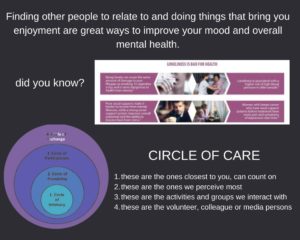 Circle of Care is an appropriate social health extension of resources for the betterment of our individual health. We require each area of support no matter how long or how often those entities are involved. To best evaluate the ideal state you are in as it pertains to social wellness, simply review the Circle of Care and determine if a) you are engaged with each of the “ones” outlined and b) if you are not, then create the resources and steps to fulfilling those bodies in your care circle. Don’t assume others will reach you especially in these uncertain times. Take personal initiatives to seek and source the “ones” you need and align the social care circle to fit you how you need it most. Don’t be shy and don’t be alone. Loneliness can be worse than smoking 15 cigarettes a day according to health statistics and if you are forced to work from home – you may also be experiencing this emotion. Treat it seriously and remember to treat yourself with care.
Circle of Care is an appropriate social health extension of resources for the betterment of our individual health. We require each area of support no matter how long or how often those entities are involved. To best evaluate the ideal state you are in as it pertains to social wellness, simply review the Circle of Care and determine if a) you are engaged with each of the “ones” outlined and b) if you are not, then create the resources and steps to fulfilling those bodies in your care circle. Don’t assume others will reach you especially in these uncertain times. Take personal initiatives to seek and source the “ones” you need and align the social care circle to fit you how you need it most. Don’t be shy and don’t be alone. Loneliness can be worse than smoking 15 cigarettes a day according to health statistics and if you are forced to work from home – you may also be experiencing this emotion. Treat it seriously and remember to treat yourself with care.
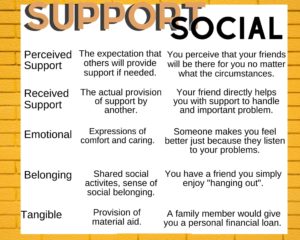
play therapy
Forget Media and Socialize a Senior
- Sign up to be a volunteer caller and call a senior isolated by COVID-19. Anybody can provide social
 support. Similarly, if you know a family member or loved one who is isolated, you can help sign them up to receive calls. It’s not just a one-time thing either. People will need support for the weeks or months to come.
support. Similarly, if you know a family member or loved one who is isolated, you can help sign them up to receive calls. It’s not just a one-time thing either. People will need support for the weeks or months to come. - Identify the needs in your neighborhood: Who needs groceries? Who needs to pick up a prescription? Who needs help walking a dog? Vulnerable groups should stay at home as much as possible,so if you are healthy, offer to help others run their essential errands. Join NextDoor, which is similar to Facebook but for your neighborhood, to offer help or to find out which of your neighbors
 could use help.
could use help. - Provide letters and care packages: While most nursing homes and senior living facilities are closed to external visitors, they can still accept packages. Call your local senior living facility and ask what their residents might appreciate in the form of a care package. Deliver yourself or send it through the mail.
- Donate your iPad or other tablets to a senior living facility: Access to technology might be a barrier for seniors who would like to video conference with their family members or others. Reset your device and install a video conference system like Zoom and send it with easy instructions on how to get started.
- Reach out to family or friends who are caregivers to seniors: Over 40 million people in the US provide care to a senior. Chances are, if you’re not already a caregiver, you know someone who is. They may be stressed or worried. Their caregiving job, and any other professional job, just got a lot harder. Tell them you are thinking of them and offer to do any of the above for their loved one. Offer to run any of their errands. Caregiving can be one of the hardest and loneliest jobs, and in this time of increased uncertainty, a little kindness and compassion can go a long way.
Though social isolation is most dramatic for seniors, we all need human connection. The already serious problem of social isolation that preceded COVID-19 has precipitously accelerated to full-on crisis. The dangers of exposure to COVID-19 are real and scary. The extreme isolation that comes with it makes a bad situation worse. With this challenge is a tremendous opportunity to establish and nurture relationships using technology and old-fashioned neighborly care that is the lifeblood of healthy communities.
Source: Joy Zhang, Co-Founder, Mon Ami
Storytelling therapy
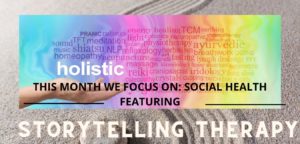
Narrative therapy is a style of therapy that helps people become—and embrace being—an expert in their own lives. In narrative therapy, there is an emphasis on the stories we develop and carry with us through our lives.
The goal is to uncover opportunities for:
- growth and development
- finding meaning
- understanding ourselves better
We use stories to inform others, connect over shared experiences, say when we feel wronged, and even to sort out our thoughts and feelings.
Stories organize our thoughts, help us find meaning and purpose, and establish our identity in a confusing and sometimes lonely world.

We all have different methods of telling our stories, and historically we have used various forms of art to do so.
You could:
- Meditate. Guided relaxation or individual meditation to explore a problem.
- Journal. Consider a specific set of questions.This can be difficult but can lead to a greater understanding of the problem and how it influences the domains of your life.
- Draw. You can draw the effects of the problem. Use symbolism, map the effects or create cartoon representations of the problem in your life. You can even doodle abstract shapes with the colors of the emotions you feel, and keywords that express your reflection in that moment.
- Movement. You can use movement and mindfulness to create and express your story. Begin by moving in your usual way, then allow the problem to influence your movement. Lyrical dancing come to life as you move through the motions of your emotions.
- Visualization. Consider how your life might be in a week, a month, a year, or a few years, both with this problem continuing and in a timeline where you embrace a new direction. Share your experience with a partner or therapist to explore the ways in which this exercise helped you find meaning or new possibilities for your life.

intellectual
mentorship
 I began my career in marketing in 2008. Having graduated with a degree in Information Technology Management, this wasn’t the career path that I expected to follow, but as it does for so many others, I was guided down a different path and never looked back.
I began my career in marketing in 2008. Having graduated with a degree in Information Technology Management, this wasn’t the career path that I expected to follow, but as it does for so many others, I was guided down a different path and never looked back.
Marketing is one of the many careers, where people tend to get better with experience. Since it relies on skills like creative thinking and persuasion, there are only so many courses that one can take to further develop their skills. As such, Mentorship plays a huge role in this industry – and I attribute much of my career development to my experiences with Mentorship.
Search for a definition of Mentorship online and you’ll find a number of complicated responses. Simply put, MENTORSHIP IS A RELATIONSHIP IN WHICH A PERSON WITH EXPERIENCE (THE MENTOR) OFFERS ADVICE, GUIDANCE OR KNOWLEDGE TO SOMEONE WITH LESS EXPERIENCE (THE MENTEE)
I’ve been fortunate to have some great formal and informal mentors over the years – both through programs within the companies that I’ve worked for as well as through professional organizations like the AMA > Toronto.
Through these relationships, I have gotten advice on how to advance my career, how to be better at what I do, how to be a better leader and some general life lessons. These experiences have been invaluable to my career.
Fact, 97% OF MENTEES SAY THAT THEIR MENTORSHIP EXPERIENCES ARE VALUABLE… AND YET, ONLY 37% OR PROFESSIONALS HAVE A MENTOR.
The benefits of Mentorship don’t stop there… participating in a Mentorship program can lead to increased rates of productivity, job promotion, salary increases, confidence and job satisfaction.
On the flip side, becoming a Mentor is one of the easiest ways that someone with experience can “give back” and help themselves at the same time. Not only does it feel good to know that you’re helping someone out, in a strong Mentor/Mentee relationship both parties are learning from each other.
So now that you’re interested, how do you get started?
If you’re currently employed, find out if your company either offers an internal Mentorship program or if they’ll cover the cost for you to participate in an outside Mentorship program. From there, reach out to relevant industry associations and see if they offer formal programs. As a last resort, do some outreach on networking platforms like LinkedIn.
You would be surprised how many people are happy to donate some time for a virtual chat to share their experience. I’ve been on both sides of the table, having both reached out to leaders in my industry that I admire and would love to learn from as well as offering up my time to people that have reached out to me. In a time when COVID-19 has left many of us struggling emotionally as it relates to employment, a conversation with a stranger can have a huge positive impact. It can also be the start of a long-term friendship (as the saying goes, a stranger is just a friend that you haven’t met yet).
Ok – we’ve discussed the benefits of Mentorship and how to get started. Now let’s cover the ground rules. Mentorship is about a mutually beneficial relationship where ideas, advice and knowledge are exchanged.
Some rules to follow:
· Your Mentor is not a therapist. Keep your conversation focused on your goals and how to best achieve them
· Your Mentor is not a ticket to a job. Although Mentorship can lead to career opportunities, the Mentor’s role is to offer guidance
· Own the Process. To get the most from your time, do your Mentor a favour and own the process. Book the meetings, take notes and share them, and make it easy on your Mentor to spend time with you.
· Determine a frequency for meetings. Leaving space between meetings allows time to reflect on your last conversation, to work towards goals and to think up new discussion topics. Monthly, bi-monthly or quarterly are good examples of a meeting schedule.
· Set goals. What do you want to accomplish through these meetings? Review your goals and you progress at each meeting
· Prepare your Mentor. Reach out in advance of your meeting with a review of the last meeting’s discussions and any topics that you want to discuss. If your Mentor has an idea of what to expect, they’ll
· Be respectful! Remember that someone is volunteering their time to help you. This is a gift!
Engaging in a Mentor / Mentee relationship can be an incredibly rewarding experience for both parties. My Mentors have helped me get to a place in my life and career where I feel fulfilled and that I have a sense of direction. As a Mentor, I love meeting new people and knowing that my experience is helping them on their own journeys.
Ethan Zon is the Senior Director of Strategy at Influence Marketing. He is a Mentor in the AMA > Toronto’s Career Accelerator Program and occasionally guest lectures at various post-secondary institutions.
spiritual
dream life
Connecting a higher power to support mental health.
Journaling
 Its been discussed before in support of our mental health but what really are the benefits of journaling and what to write, and when to do it, and how to start?
Its been discussed before in support of our mental health but what really are the benefits of journaling and what to write, and when to do it, and how to start?
IT may seem like a daunting idea for some who may have given up handwriting when they stopped having to handwrite their public school projects and English studies, I mean, for many – there is no applied or practical requirement for handwritten anything in their tech-savvy day to days,
But it’s great to practice the art of writing and this is one great reason why you should do it every day. For starters, it can help you to express your thoughts and ideas, as well as improve your overall communication skills.
Here are 5 of the top benefits we discovered:
- Reduces Stress. An overabundance of stress can be damaging to your physical, mental, and emotional health.
- Improves Immune Function.
- Keeps Memory Sharp.
- Boosts Mood.
- Strengthens Emotional Functions.
So how do get started on this? Well experts say the time of day is important and making it a part of your everyday routine. Here are their tips:
- Use a real journal.
- Start first thing in the morning.
- Set reminders on your phone
- Find fun journal prompts.
- Free write.
- Ask yourself questions.
- Don’t limit yourself to just writing.
- Make lists.
Intention and action this with also applying your dreams to the mix as it will manifest along with you on your journaling journey too!
The Healing Herbs examines 100 of the most widely used, most easily available, most familiar, and most fascinating medicinal plants. It traces there history, folklore, and healing properties, and summarizes the latest scientific research on their many benefits. The book also explains where to find the herbs, how to take them, store and prepare them.
